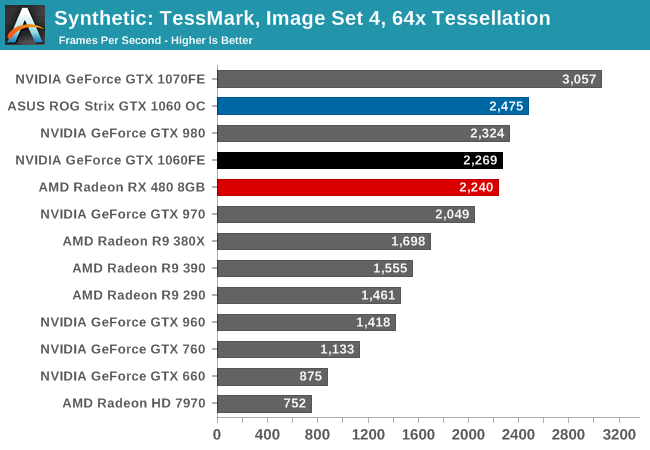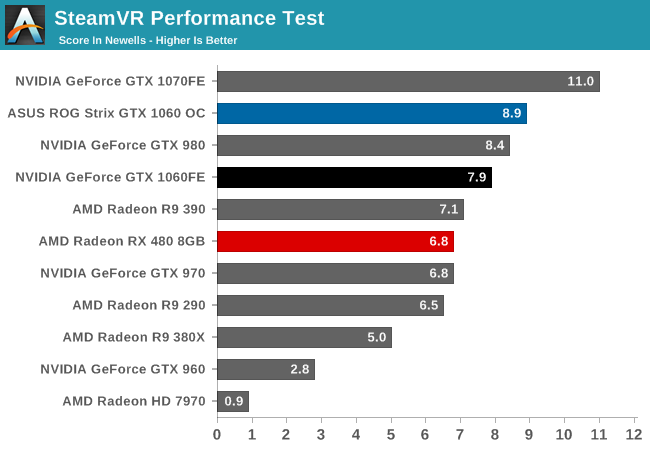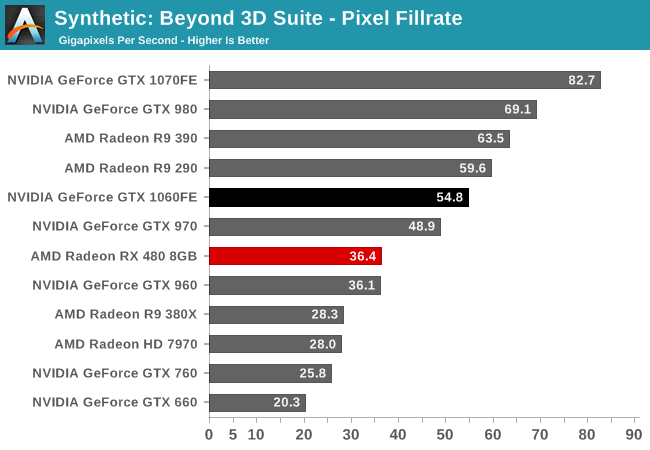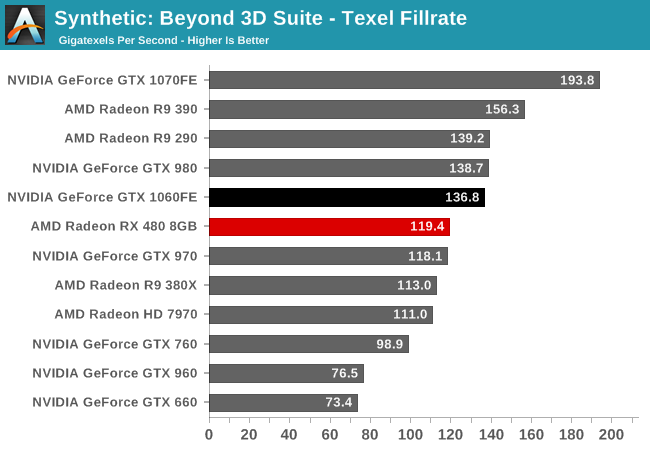The GeForce GTX 1060 Founders Edition & ASUS Strix GTX 1060 Review
by Ryan Smith on August 5, 2016 2:00 PM ESTSynthetics
As always we’ll also take a quick look at synthetic performance. While GTX 1060 is of course a cut down Pascal architecture part, how it has been cut down is interesting. Compared to GP104, GP106 has half the SMs and GPCs, but 3/4 the ROPs, which may prove to have an impact.

Starting off with tessellation performance, we find the GTX 1060 coming in just behind the GTX 980, showing that NVIDIA’s performance estimates generally apply not only to games, but synthetic tests as well. But perhaps more interesting is the fact that the card is neck-and-neck with the Radeon RX 480. NVIDIA has traditionally enjoyed a sizable geometry performance lead over AMD cards, but it looks like those days have come to a close.
Up next, we have SteamVR’s Performance Test. While this test is based on the latest version of Valve’s Source engine, the test itself is purely synthetic, designed to test the suitability of systems for VR, making it our sole VR-focused test at this time. It should be noted that the results in this test are not linear, and furthermore the score is capped at 11. Of particular note, cards that fail to reach GTX 970/R9 290 levels fall off of a cliff rather quickly. So test results should be interpreted a little differently.

As NVIDIA’s now entry-level VR card, GTX 1060 looks very good in the Steam VR test. A score of 7.9 Newells means that it’s comfortably above the 6.x range generally required, and it also means the GTX 1060 is comfortably ahead of the RX 480 in this scenario.
Finally, for looking at texel and pixel fillrate, we have the Beyond3D Test Suite. This test offers a slew of additional tests – many of which use behind the scenes or in our earlier architectural analysis – but for now we’ll stick to simple pixel and texel fillrates.

Starting with the pixel fillrate, we can see the impact of GTX 1060’s slightly more unusual ROP and GPC arrangement when it’s compared to the GTX 980. At 54.8 GPixels/second, GTX 1060 trails GTX 980 significantly. The card not only has fewer ROPs, but it has half of the rasterizer throughput (32 pixels/clock) as GTX 980. As we’ve seen in our gaming benchmarks the real-world impact isn’t nearly as great as what happens under these synthetic tests, but it helps to explain why sometimes GTX 1060 is tied with GTX 980, and other times it’s several percent behind. If nothing else, at an architectural level this is what makes GTX 1060 a better 1080p card than a 1440p card.

As for texel throughput, things are right where we expect them. GTX 1060 is virtually tied with GTX 980, and while it’s ahead of RX 480 in the process, it’s not by a massive amount.










189 Comments
View All Comments
anandreader106 - Friday, August 5, 2016 - link
First thought: Still no Doom benchmarks being factored in?Ryan,
You are my favorite GPU reviewer. Period. However I do think I need clarity on your Final Words.
It's my opinion that DirectX 11 performance is "good enough" from Nvidia and AMD thus far in this new generation. So I'm left wondering, why aren't you going more in-depth with DirectX 12 and Vulcan titles/performance? Wouldn't that give us the best indication of what to expect going forward?
cknobman - Friday, August 5, 2016 - link
The best indication you will get is that when reviewing Nvidia cards none of these things will be addressed?Why, because Nvidia is not doing so hot at them and it would not make their cards look better than AMD's.
Look at the other 1060 benchmarks and comparisons and you will see that:
A. Nvidia is behind on dx12 and the 480 => 1060
B. @1080p the 1060 is overkill and a $200 480 4gb (or even a $180 470) is all you need
C. Because of Nvidia's "founders edition" price gouge model most 3rd parties are trying to get away with charging more than $250. Reality is most 1060's are >= $270 which makes the AMD 480 the better buy.
StrangerGuy - Friday, August 5, 2016 - link
It's funny the AMD fanboys always harp about the evil $300 1060 and never mentions how their favorite $200 480 is essentially vaporware and 8GB versions price gouged to death.Ryan Smith - Friday, August 5, 2016 - link
"It's my opinion that DirectX 11 performance is "good enough" from Nvidia and AMD thus far in this new generation. So I'm left wondering, why aren't you going more in-depth with DirectX 12 and Vulcan titles/performance? Wouldn't that give us the best indication of what to expect going forward?"The benchmark suite only gets updated periodically. It's a lot of effort to design and validate a testing sequence, and then run (and possibly re-run) 30 some-odd cards through it. So adding games has the net effect of slowing things down even further.
At this point we're updating the testbed to Broadwell next month, at which point we'll refresh the games list as necessary.
Though I will note that there's a reason we run so many (9) games: one game is too small of a sample size. Right now Doom is the only Vulkan game on the market,* so while it's a very interesting first look at Vulkan, it's not something that's going to be representative of Vulkan as a whole.
* We'll ignore DOTA 2 since it's not meaningfully GPU limited on these fast cards
CHADBOGA - Friday, August 5, 2016 - link
Doom is one of those few games out there that will inspire people to go one way or the other and should be included in your benchmark suite.Scali - Saturday, August 6, 2016 - link
Aside from that, the Vulkan implementation in DOOM is not yet complete.As you can read in the DOOM FAQ, they use AMD shader intrinsics extensions, but no equivalent for nVidia. Likewise, on AMD hardware, async compute is enabled, on nVidia it is not yet. The FAQ says they're still working on optimizing the code with nVidia.
While it may be interesting to benchmark DOOM's Vulkan implementation to get an idea of where we currently stand, I don't think it is mature enough at this point to say anything about performance in Vulkan games in general, or how AMD and nVidia stack up, since you're comparing apples to oranges at this point.
rhysiam - Friday, August 5, 2016 - link
I too am curious as to why the whole DX11 vs 12 comparison wasn't even raised. DX12 does not appear once in the conclusion page. The 1060 is the better DX11 card, no question. It's early days for DX12, but what we're seeing so far is enough to suggest things may well be quite different. The three DX12 titles in the review (Hitman, RoTR & AoS) are the three strongest games for the 480 by far. Add Doom via Vulkan into the mix and you have 4 NextGen API titles that put the 480 at or above 1060 performance. Of course we can't make hard and fast recommendations based on a few titles like this, but surely it's worth mentioning at least, if not exploring in detail?This might be a minor point except for the fact that you dismiss the 4GB 480 based on speculation/extrapolation that its VRAM won't be enough to keep it competitive future demanding titles. Surely those demanding titles will increasingly be (or at least offer) DX12 though? So if you're advocating a 1060 over the 480 4GB based on longevity and future performance, the DX12 question has to be raised doesn't it?
rj030485 - Friday, August 5, 2016 - link
Think Ryan needs to work on his math. He says the 1060 is 17% faster than the 480 in GTA V when the difference more like 30%.Ryan Smith - Friday, August 5, 2016 - link
Oh geeze. This is what happens when you read the wrong column in a spreadsheet. Thanks!onemoar@gmail.com - Friday, August 5, 2016 - link
I don't know why anands witcher 3 scores are so lowI am pushing 80FPS in places with everything turned up to ultra and post effects on with no hairworks